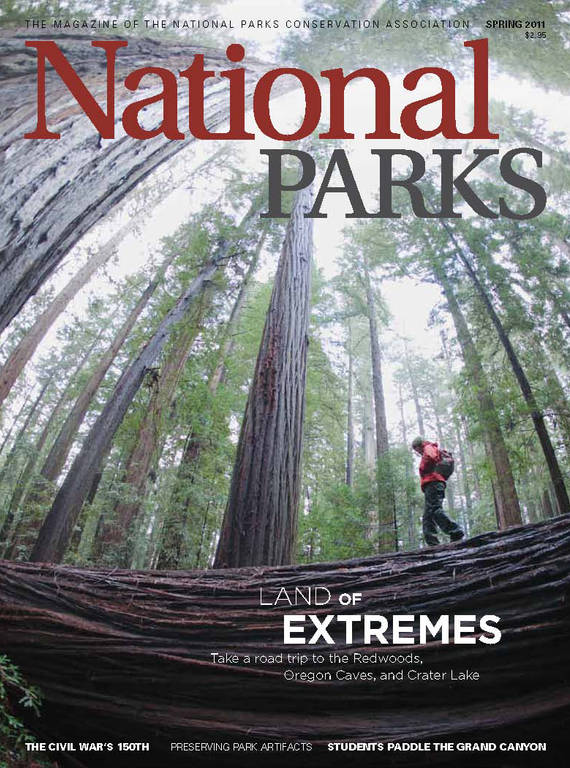Spring 2011
A Leap of Faith
What will it take to save California’s yellow-legged frog?
Clouds of mosquitoes assault Vance Vredenburg’s skin as he crouches beside a pond in California’s Sixty Lake Basin. In this remote corner of King’s Canyon National Park, the tiny bloodsuckers outnumber people by a million to one. Vredenburg makes regular forays here to study yellow-legged frogs, which seem immune to the swarm, but their skin is actually under attack from another, much deadlier menace: chytridiomycosis, or chytrid, a fungus that has decimated frogs that were once as abundant as the mosquitoes.
For Vredenburg, a biology professor at San Francisco State University, getting here requires a 17-mile hike over three mountain passes that reach nearly 12,000 feet. “These are the most pristine areas we have,” he says, “yet even here, frogs are disappearing. Now, when you look into these high-mountain lakes, you see no life, not even a tadpole.”
This new disease began invading High Sierra lakes and streams in the 1960s or ’70s. Now, Sixty Lake Basin, once home to the world’s largest-known population of yellow-legged frogs, supports just 100 individuals. “There used to be so many frogs that when they started hopping away, it looked like the whole shore was moving,” recalls Harold Werner, a wildlife ecologist at Sequoia and Kings Canyon National Parks, about a site he observed in the early 1990s. Yet from Yosemite National Park to the hills above Los Angeles—the species’ entire range—only 5,000 adults remain.
Chytrid has driven at least 200 of the planet’s 6,700 amphibian species to extinction and threatens one-third of remaining frogs, toads, and salamanders. It’s the worst case in recorded history of a single pathogen causing damage to vertebrates.
But for the Sierra’s iconic frog, chytrid is just the most recent blow. In the late 1800s the population was weakened by non-native trout introduced to mountain lakes that previously contained no fish (settlers found the fishless waters strange and unnatural). The transplants wreaked havoc on the frogs, devouring tadpoles and interfering with their lake-to-lake migrations. When chytrid arrived, it found a compromised frog population that wasn’t robust enough to resist the disease.
Now the race is on to save yellow-legged frogs before they disappear completely. Most efforts have focused on trout removal: Various agencies, including the Park Service, have used gill nets to remove fish from lakes and “electrofishers” to stun fish in streams, sending them to the surface where they’re netted and destroyed. NPCA has supported efforts to remove fish and has worked to educate the public about the need to restore fish-free habitat. In such waters, frog populations have increased up to 17 times—and bigger populations are better able to resist chytrid by improving the odds that a few individuals will have natural resistance to the disease.
Vredenburg, meanwhile, is pursuing a different avenue. After noticing that some frogs carry bacteria that are toxic to chytrid, he designed an experiment to see whether distributing those bacteria among the larger population might counteract the fungus. So he has been trekking into Sequoia and Kings Canyon’s backcountry, capturing frogs and dipping them in a bacterial bath before releasing them. It’s too soon to tell whether the inoculations will prove effective—but if they do, the study has implications for amphibians worldwide and ultimately could protect hundreds, if not thousands, of species.

National Parks
You can read this and other stories about history, nature, culture, art, conservation, travel, science and more in National Parks magazine. Your tax-deductible membership donation of $25 or more entitles…
See more ›In some circles, Vredenburg’s bacterial bath is deemed invasive and manipulative. But “that level of intervention is not as serious as the consequences to biodiversity should this species go extinct,” says David Graber, the Park Service’s chief scientist for the Pacific West Region. He thinks that desperate times call for desperate measures: If invasive methods can save species from extinction, they’re worth pursuing, even within our national parks. For example, Sequoia and Kings Canyon propose to poison trout out of their waters—something that Wilderness Watch and some members of the public oppose. Yet electrofishing is tedious (one ten-year effort produced just 1.4 miles of fish-free stream), and because the basins are interconnected, fish re-inhabit waters where others were removed. “We’re looking at 50 miles of stream we’d like to treat over the next 20 to 30 years, and there’s simply no way to do that without chemicals,” says Werner. “We’re pursuing short-term impact for long-term preservation.”
Should the yellow-legged frog disappear, the High Sierra would lose its keystone species. If it rebounds, other species will follow suit: birds, snakes, insects, and likely bats and small mammals. “A complex system has a lot of checks and balances in it, which support ecological diversity,” explains Werner.
Besides, says Vredenburg, if humans brought on the factors that are devastating yellow-legged frogs, we bear the burden of attempting a remedy. “These systems can bounce back,” he promises, “if we just give them the chance to do it.”



